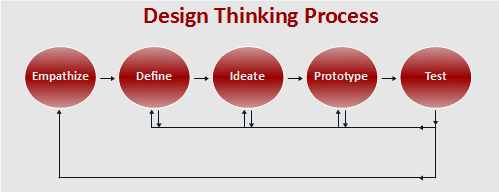Design thinking is a solution-focused, problem-solving methodology that helps companies, and individuals alike to get the desired outcome on an inner problem, or to work forward on a future plan. Design thinking is a methodology for creative problem-solving.

The 5-stage process of design thinking was originally proposed by the Hasso-Plattner Institute of Design at Stanford University, California. It is continually used by individuals and firms to facilitate superior innovation.
The 5 processes are,
1. Empathize: Research your user needs
The
first stage of the process is empathy, it
provides the critical starting point for design thinking and is spent getting to know the user and
understanding their wants, needs, and objectives. This stage allows you to gain
an empathetic understanding of the problem you’re trying to solve, typically
through user research.
This means observing and engaging with people in order to understand them on a psychological and emotional level. In this phase, the designer keeps their assumptions aside and gather real insights about the user.
This step is very crucial in the design thinking process because it allows you to keep your assumptions aside and to gain real insight into users and their needs.
2. Define: State your user’s need and
problem
This stage is
dedicated to defining the problem. You’ll gather all of your findings from the
empathize phase and start to make sense of the findings. In this step, the team
should seek to define the problem in a human-centered manner.
This define stage will be used to gather ideas and be able to understand how to use them effectively. From here, the team will start to progress into the third stage of Design thinking, Ideate.
3. Ideate: Challenges assumptions and
create ideas
The third phase in the design thinking process is where the creativity happens, and it’s crucial to point out that the ideation stage is a judgment-free zone. Designers will hold ideation sessions
in order to come up with as many new angles and ideas as possible.
From here, your team will start to make ideas that may be “out of the box” or perhaps just ideas that may normally be skipped over when not all of the information is presented. This stage allows for an alternative way to solve normalized problems.
By the end of this phase, your team should have a few ideas to solve the problem. It’s important during this phase that your team should generate a lot of ideas just so you have many to choose from when starting the next phase in the design thinking process called the “Prototype” stage.
4. Prototype: Start your create solutions
During this stage, the team will work on creating a number of
inexpensive products with specific features. This allows for the design thinkers to investigate possible solutions to the problems that were identified in the earlier stages of the design thinking process.
With each new prototype, the team investigates different aspects of the problem and explores how each of the prototypes would fix the problem. This process also allows the designers to be aware of the problems that would be created by each prototype and how they can workaround to fix the prototype to make it fundamentally better.
By the end of this stage, the design thinkers should have a better understanding of the constraints they are apparent in the prototype. From here, the team should be ready to move on to the final step of the design thinking process called the ‘Test’ stage
5. Test: Try your solution out
In this fifth and final stage of design thinking, testing of the prototypes made in stage four is conducted. In this step,
testing of the prototype is done to see how well they solve/handle the problem that they initially defined in stages one and two.
This process allows to go back to the previous stages and revise the information to get the best outcomes for the end product. In reality, the results of the testing phase will often lead you back to a previous step, providing the insights you need to redefine the original problem statement or to come up with new ideas you hadn’t thought of before.
Essentially, the team can continue to do this until they are either solving their problem or until they are satisfied with their product.
Design thinking gives good solutions to many problems
Design thinking has been taking shape for the past fifty years. In the corporate world, it was not long before design thinking became the newest
trend. If we use design thinking properly it will provide good solutions for
many problems. The other advantage of design thinking is that it not only helps
solve problems but also brings divergent voices to the table and is a low-risk
approach.
